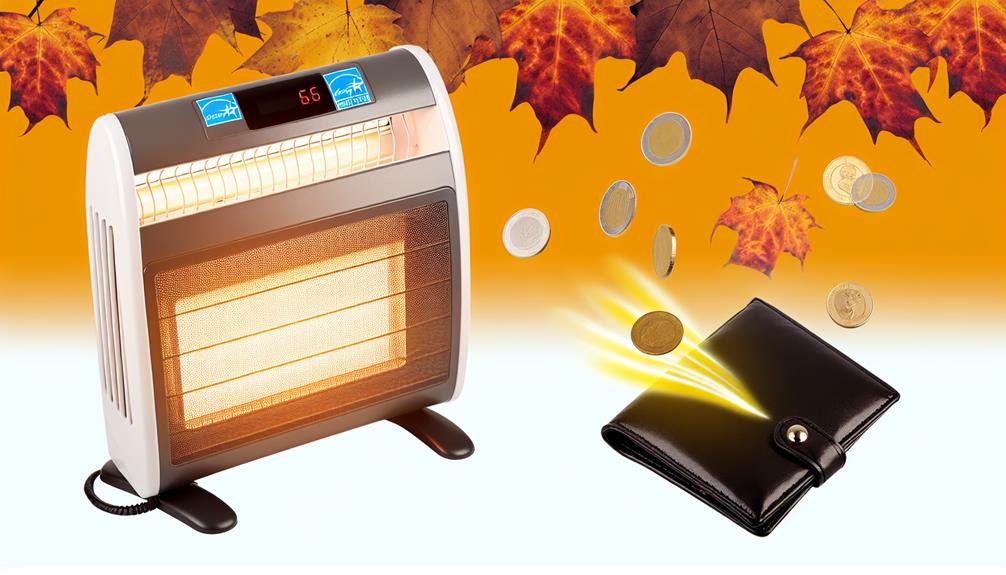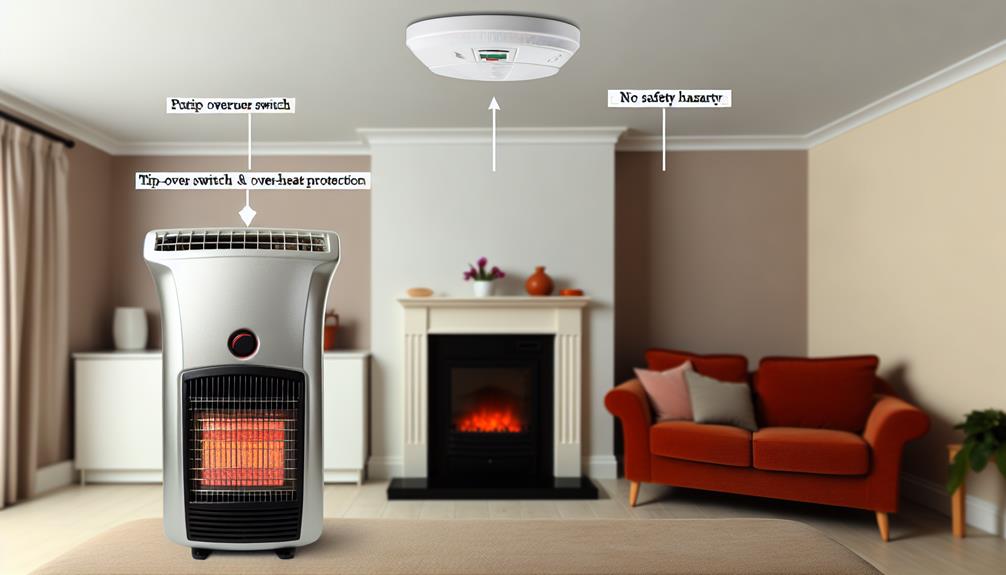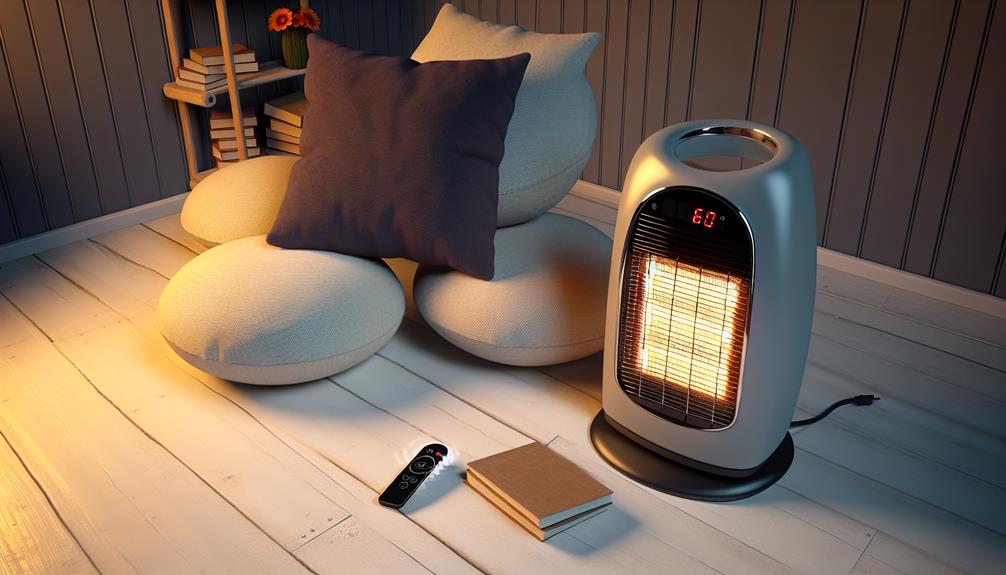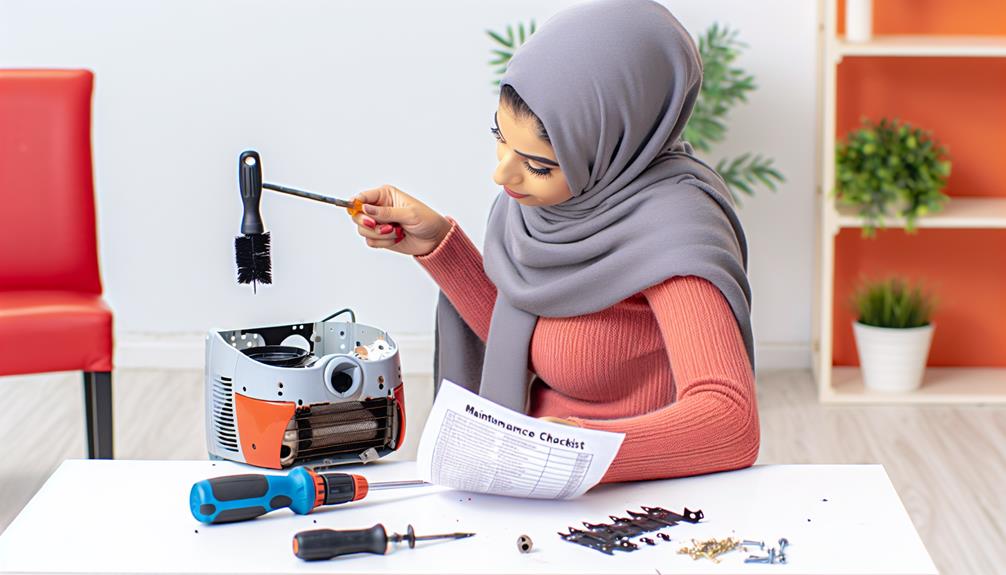Navigating the market for portable heaters is like walking through a labyrinth, with a myriad of options at every turn. You're faced with choices that range from electric to gas-powered, infrared to oil-filled, and everything in between. It's essential you understand the heating capacity you need for your space, as well as the type of heater best suited for your comfort and budget. As you weigh the benefits of energy savings against upfront costs, you'll also want to consider the long-term implications of your decision. And let's not overlook the importance of safety features, which can safeguard your home from potential accidents. With winter's chill fast approaching, you'll need to arm yourself with the right information to make a decision that promises warmth without wasting your hard-earned money. So, as you stand at the crossroads of choice and necessity, what factors will guide your next step?
Key Takeaways
- Understand the different types of heaters available, such as convection, radiant, fan-forced, and wall heaters.
- Consider the size of your space and calculate the required heat based on cubic footage and temperature rise.
- Look for energy-efficient heaters with certifications like Energy Star to reduce costs and environmental impact.
- Choose heaters with advanced technologies and thermostat control for precise temperature management and increased efficiency.
Understanding Heater Types
When selecting a portable heater, it's crucial to understand the different types available and how they align with your specific heating requirements and room layout. This Space Heater Buying Guide will help you navigate through the variety of electric space heaters, focusing on heating technologies and styles that are suitable for supplemental heating.
Convection heaters are ideal if you're after quiet, whole-room heating. They work by circulating warm air throughout the space, offering a consistent temperature. These heaters are a good match for rooms where you'll spend extended periods, as they take a little time to warm up the area.
Radiant or infrared heaters provide quick warmth by directly heating objects and people in their path. They're perfect for spot heating or in drafty areas where you need immediate warmth. They don't raise the room temperature uniformly but offer fast relief from the cold.
Fan-forced heaters use a fan to blow air across a heating element, which then distributes the heated air throughout a room. This forced air method can quickly warm a space, making it a popular choice for busy, frequently used areas.
Lastly, wall heaters can be a more permanent solution for consistently under-heated rooms. They're mounted on the wall and can save floor space, making them a smart option for smaller rooms.
Be sure to consider wattage and square footage recommendations to ensure your chosen heater effectively meets your needs.
Sizing Heaters for Your Space
Having familiarized yourself with the different types of portable heaters, it's essential to now focus on sizing the heater to your specific space requirements to achieve optimal comfort and efficiency. When buying a space heater, the size of the space is a critical factor. Measure the cubic footage to gauge the volume accurately, considering ceiling height for effective heat distribution.
To calculate the required amount of heat, factor in the needed temperature rise—the difference between the current and desired temperatures. Each cubic foot requires 0.24 BTUs for adequate heating performance. Once you've obtained the total BTUs, convert this figure to watts by dividing by 3.41, as most portable space heaters are rated in watts.
In your quest for the right electric space heater, consider when buying the heater's wattage and square footage capabilities. Refer to a space heater buying guide that matches wattage recommendations with the square footage of your area. This ensures you're not purchasing a unit that's too small, which would struggle to heat the room, or too large, which could lead to unnecessary power consumption. Always aim for a balance between size, wattage, and your room's specific heating needs for optimal efficiency.
Energy Efficiency and Cost

When choosing a portable heater, you should consider the energy ratings to understand its efficiency. Long-term operational costs can vary, so it's crucial to assess not just the purchase price but also the ongoing expenses. Additionally, exploring eco-friendly heater options may offer you both energy savings and a reduced environmental impact.
Heater Energy Ratings
Understanding the energy ratings of portable heaters, such as the Energy Star certification, is crucial for gauging their efficiency and potential cost savings. When consulting an Industrial Heater Buying Guide, consider these factors:
- Watts of heating power: Electric heaters with higher watts can produce more heating power, but may also consume more energy.
- Energy ratings: Look for certifications that indicate efficiency; Energy Star-rated heaters often use less energy and save money in the long run.
- Consumption and Cost: Assess the amount of energy a heater uses to estimate the operating cost.
Long-Term Operational Costs
Energy efficiency is a decisive factor in the long-term operational costs of portable heaters, impacting both your wallet and the environment. When you're heating with little regard for electricity usage, the cost per day can soar. On the flip side, selecting energy-efficient models with advanced heating element technologies can drive down those costs. Heater efficiency isn't just about the immediate warmth—it's about how much energy is consumed to maintain that warmth over time.
Heating technologies have evolved, and now many portable heaters boast energy-saving features like thermostat control, which allows for precise temperature management. By choosing a heater with such features, you're not only ensuring efficient energy use but also keeping operational costs in check. Always analyze the energy efficiency rating and estimated operational costs before purchasing to optimize your investment.
Eco-Friendly Heater Options
Opting for an Energy Star-certified heater is a smart choice that can significantly reduce your utility bills and minimize your carbon footprint. When exploring eco-friendly heater options, it's important to consider not only the upfront cost but also the long-term energy savings. Here are some key features to look for in an energy-efficient space heater:
- Technologies such as micathermic heating, which combines radiant and convection heating, can improve efficiency and maintain better air quality.
- A built-in thermostat to maintain consistent temperatures, and automatic shut-off to prevent overheating and energy waste.
- Electric space heaters with an advanced heating element that requires less energy to produce the same amount of heat.
These features not only contribute to a greener home but also ensure you're getting the most for your money.
Key Safety Features

When selecting a portable heater, it's crucial you consider the built-in safety mechanisms that protect against common hazards. Features like an overheat protection mechanism and a tip-over safety switch are essential for reducing the risk of fire and injury in your home. Moreover, opting for a unit with certified safety standards ensures that your portable heater adheres to rigorous industry guidelines for safe operation.
Overheat Protection Mechanism
An overheat protection mechanism acts as a critical safeguard for portable heaters, automatically powering the unit down if internal temperatures climb to dangerous levels. This feature is vital for heater safety, ensuring that when using a space heater, the risks of overheating are minimized. Here's what you need to know:
- Overheat protection helps heaters work safely, preventing fire risks.
- It allows for effective heating without compromising on safety.
- The mechanism can automatically turn off the heater, avoiding potential overheating.
When choosing a portable electric heater for your needs, consider models with adjustable heat settings and proper power cord placement. These factors, combined with overheat protection, contribute to a safer and more efficient heating experience.
Tip-Over Safety Switch
Guarding against accidental falls, the Tip-Over Safety Switch in portable heaters is a crucial feature that instantly cuts power if the device is tipped over, thereby mitigating fire hazards and enhancing user safety. When you're choosing a heater to provide supplemental heat in a space or room, it's essential to adhere to safety guidelines. Portable heaters with a tip-over safety switch offer an important safeguard.
| Feature | Benefit | Consideration |
|---|---|---|
| Tip-Over Safety Switch | Cuts power to prevent fires | Must-have for enhanced safety |
| Overheat Protection | Shuts off heater if too hot | Complements tip-over switch |
| Supplemental Heat | Provides additional warmth | Always follow safety guidelines |
Always check for this feature to ensure the heater you select is equipped with reliable safety mechanisms.
Certified Safety Standards
In addition to the Tip-Over Safety Switch, it's crucial to ensure that your portable heater adheres to certified safety standards, which include an array of features like overheat protection and cool-to-the-touch exteriors for comprehensive protection. When buying a portable heater, it's important to make sure that it doesn't become faulty and hazardous to your home's heating system. Look for these key aspects:
- Overheat protection to prevent potential fire risks.
- Safety certifications from recognized organizations to ensure compliance with industry standards.
- Cool-to-the-touch exteriors to safeguard against burns.
These features are vital in Industrial Heater Buying and serve as helpful air quality resources. Always consider these Things to Consider to guarantee your portable heater operates safely and efficiently within your living space.
Noise Levels and Convenience

When selecting a portable heater, consider the noise level and convenience features, as they can significantly impact your comfort and the heater's suitability for your space. A good space heater should provide warmth without becoming a distraction. Convection heaters, known for their quiet operation, can be an excellent choice for whole-room heating. They work by naturally circulating warm air without the need for a blower fan, reducing noise levels and enhancing convenience.
Fan-forced heaters, on the other hand, use a blower to distribute heat, which can make them noisier. However, the design features of some models can help minimize this noise. If you're looking for quick warmth with minimal sound, radiant or infrared heaters might be your best bet, as they directly heat objects rather than the air.
Bonus features like a remote control can add to the convenience of how your heater works, allowing you to adjust settings from across the room. When assessing noise levels and convenience, be sure to test the heater or read reviews to ensure it meets your expectations. Remember, the right model will combine the necessary heating capabilities with design features that align with your need for a peaceful and convenient heating solution.
Additional Heater Features
Beyond basic heating, modern portable heaters often come equipped with additional features designed to enhance user control and energy efficiency. When considering a heater's capabilities, you might want to think about the number of heating elements it has. More elements can mean a more consistent stream of hot air and the ability to heat directly, which can be more effective than trying to warm air throughout a room.
Here are some notable features that can make a difference:
- Adjustable Thermostat: This lets you choose the exact temperature for your space, sometimes using an infrared thermometer for precision.
- Energy-Saving Modes: Select between high and low settings to serve as primary heat or just to supplement it, optimizing your energy use.
- Safety Features: Look for overheat protection to prevent accidents, and never plug a heater into a power strip, which can be a fire hazard.
Maintenance and Care Tips

Understanding the advanced features of portable heaters is crucial, but ensuring they continue to operate safely and efficiently requires regular maintenance and attentive care. Portable heaters are great for keeping your personal space at a comfortable room temperature, whether they're freestanding or mounted on the wall. To ensure they work well throughout their lifespan, it's essential to follow some maintenance and care tips.
Firstly, frequently clean your heater to remove dust and debris, which can hinder performance. When using the heater, always check for any signs of wear and tear. If you spot any damage, replace the parts promptly to prevent further issues. It's also important to ensure proper ventilation around the heater; this helps to prevent overheating—a risk that can be mitigated with features like overheat protection.
Moreover, if you're not using the heater to keep warm, store it correctly to avoid damage and to extend its longevity. This includes keeping it in a dry, safe place where it won't be knocked over or covered with other items. Lastly, don't underestimate the value of professional maintenance checks. Regular servicing ensures your heater remains safe to use and efficient, saving you money and worry in the long run.
Frequently Asked Questions
How Do I Choose a Portable Space Heater?
You'll want to consider heating capacity, energy efficiency, and safety features when choosing a portable space heater. Assess the heater size, noise levels, and if it has a thermostat control. Think about the power source, how well it suits your climate, and the maintenance it needs. Don't forget the aesthetic appeal to ensure it fits with your decor. These factors will help you find a heater that meets your needs.
What Is the Advice on Portable Heaters?
When selecting a portable heater, prioritize energy efficiency to save on bills. Ensure it has safety features like auto shut-off, fits your space size-wise, and has tolerable noise levels. Regular maintenance can extend its lifespan. Check the heating capacity for effectiveness, and opt for models with thermostat control for convenience. Consider design aesthetics but don't overlook brand reputation, as this often correlates with quality and reliability.
What Should Be Considered When Using Portable Heaters?
When using portable heaters, it's vital to balance safety precautions with energy efficiency. Statistically, improper use leads to hazards; therefore, adhere to ventilation requirements to dodge carbon monoxide issues. Mind noise levels, place heaters carefully, and follow maintenance tips strictly. Manage cords to prevent trips, watch for overheating risks, and explore childproofing options. Always consult usage guidelines to ensure safe operation and extend your heater's life.
What Is the Best Type of Portable Heater to Buy?
Choosing the best portable heater depends on your needs. Consider energy efficiency to save on bills, safety features to prevent accidents, and heater size for your space. Noise levels matter for a quiet environment, while heating capacity ensures comfort. Look for appealing design aesthetics, low maintenance requirements, solid warranty coverage, and climate adaptability. Lastly, check user reviews for real-world performance. Balance these factors to find your ideal heater.
